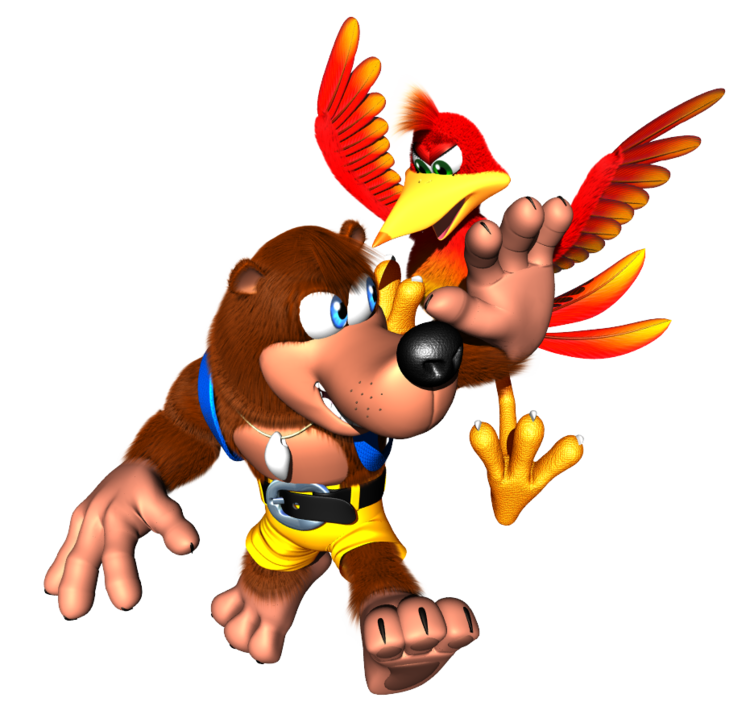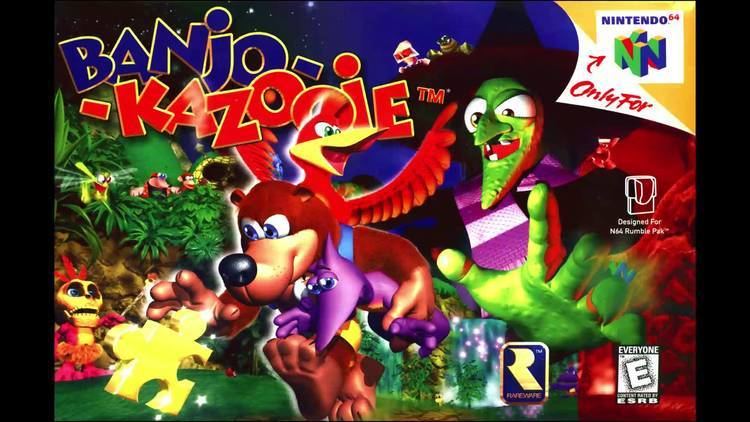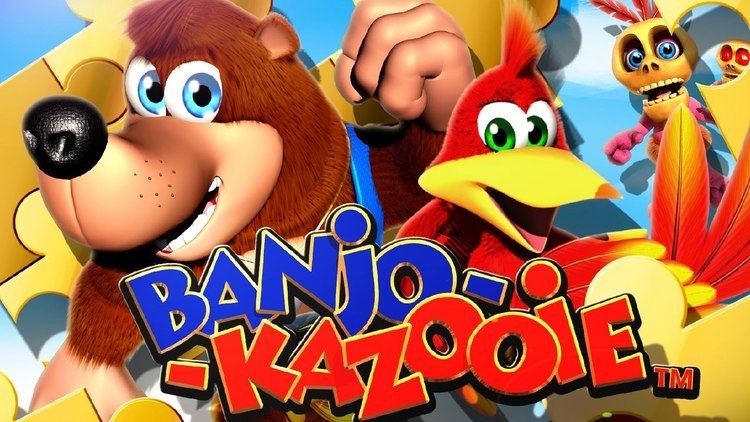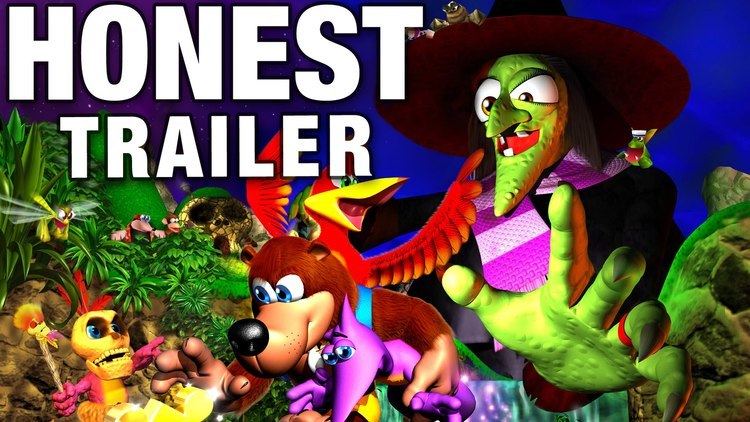9.6 /10 1 Votes9.6
Artist(s) Steve MaylesJohn Nash | 9.5/10 GameSpot Programmer(s) Chris Sutherland Mode(s) Single-player Series Banjo-Kazooie | |||||||||||||||||||||||||||||||||
 | ||||||||||||||||||||||||||||||||||
Publisher(s) NintendoMicrosoft Game Studios (X360) Release date(s) Nintendo 64NA: 29 June 1998EU: 17 July 1998Xbox 360WW: 3 December 2008 Similar Banjo-Kazooie games, Nintendo games, Platform games | ||||||||||||||||||||||||||||||||||
Banjo kazooie honest game trailers
Banjo-Kazooie is a platform video game developed by Rare and originally released for the Nintendo 64 video game console on 29 June 1998 in North America and 17 July 1998 in Europe. It is the first game in the Banjo-Kazooie series and follows the story of the title characters Banjo and Kazooie as they try to stop the plans of series antagonist Gruntilda, who intends to switch her beauty with Banjo's sister Tooty. The game features nine nonlinear levels where the player must complete a number of challenges like solving puzzles, jumping over obstacles, gathering objects, and defeating opponents.
Contents

Banjo-Kazooie was originally designed as an adventure game named Project Dream for the Super Nintendo Entertainment System, but was later changed for the Nintendo 64. The game was a critical and commercial success, selling nearly two million copies in the United States and receiving an aggregated review score of 92 out of 100 from Metacritic. The game was praised for its detailed graphics, immersive sound, and intricate level design. In 1999, it received two awards from the Academy of Interactive Arts & Sciences: Console Action Game of the Year and Outstanding Achievement in Art/Graphics. A sequel, Banjo-Tooie, was released for the Nintendo 64 in 2000. In 2008, Banjo-Kazooie was re-released for the Xbox 360 through its Xbox Live Arcade download service. The game is also included in the Rare Replay video game compilation, released for the Xbox One in 2015.

Gameplay

Banjo-Kazooie is a single-player platform game where the player controls the protagonists Banjo and Kazooie from a third-person perspective. The game is split into nine levels where the player must gather musical notes and jigsaw pieces, called "Jiggies", to progress. Players transit from one level to another through Gruntilda's lair, which acts as the game's central overworld. Jiggies allow the player to complete jigsaw puzzles which open doors to new levels, while musical notes grant players access to new inner sections of the overworld. Like in Super Mario 64, the gameplay of Banjo-Kazooie is very open and allows the player to collect Jiggies and musical notes in a nonlinear order. It is also possible to skip certain levels as long as the player has enough of these items to reach a farther one.

Each level is composed of a number of challenges that involve solving puzzles, jumping over obstacles, gathering objects, and defeating opponents. The game also features some elements of action-adventure games. Players often have to speak with NPCs and then figure out a way to help them. It is also possible to increase Banjo and Kazooie's energy bar by collecting extra honeycombs that are hidden throughout the levels. Banjo and Kazooie can perform a wide range of abilities, such as jumping, climbing, swimming, flying, and rolling into enemies. Most of these moves are learned by finding Bottles, a friendly mole, inside the worlds. Some moves require specific items so that they can be performed. For instance, red feathers allow Banjo and Kazooie to fly, while gold feathers protect them from damage. Some items also allow the character to gain temporary abilities in a particular moment. For instance, the turbo trainers provide a speed burst to reach a certain destination on time.
Banjo and Kazooie are occasionally aided by their friend Mumbo Jumbo, a shaman who can use magical powers to transform them into several creatures like a termite, a pumpkin, a bee, a walrus, and a crocodile. These transformations have their own special features and allow the player to access areas that were previously inaccessible. For instance, the walrus can resist the effects of icy-cold water. Mumbo Tokens that are scattered throughout the game allow the transformation process. The game also includes cheats that the player can unlock by finding Gruntilda's spellbook, Cheato.
Plot
Banjo-Kazooie is set in the Spiral Mountain and follows the story of Banjo, a male brown honey bear, and Kazooie, a female red-crested Breegull who is always kept in Banjo's backpack. The game begins when a foul-tempered witch named Gruntilda learns from her cauldron Dingpot that Tooty, Banjo's younger sister, is more beautiful than her. Jealous, Gruntilda creates a machine that can transfer a person's level of beauty to another, which she intends to use with Tooty. She then abducts Tooty from Banjo's house while he is sleeping. In response to the kidnapping, Kazooie wakes Banjo up and the two set out to rescue her. Banjo and Kazooie learn from Tooty's friend, Bottles the mole, that she was captured by Gruntilda and suggests they need some training to collect musical notes and jigsaw pieces to progress through Gruntilda's lair. Along the way, they are aided by Mumbo Jumbo, a shaman and Gruntilda's former teacher.
By the time most of the musical notes and jiggies are gathered, Banjo and Kazooie face Gruntilda in a trivia game show named "Grunty's Furnace Fun". The game presents questions and challenges related to certain aspects of the game. After going through several game boards, the two win the game and Gruntilda flees. Reunited with Tooty, Banjo and Kazooie return home and celebrate their victory with their friends and a barbecue. However, Tooty reminds everyone that Gruntilda has fled and orders Banjo and Kazooie to defeat her. The duo returns to Gruntilda's lair and reach the top of the tower, where they face a battle with Gruntilda. With the help of some friendly creatures called Jinjos, Banjo and Kazooie defeat Gruntilda, trapping her underneath a boulder. Returning to their home, Banjo and Kazooie go on vacation at a beach with their friends and celebrate their victory. The game ends with Gruntilda swearing revenge against Banjo and Kazooie and calling for her henchman Klungo to move the boulder that is covering her.
Development
Banjo-Kazooie was developed by Rare and designed by Gregg Mayles. The game evolved from Project Dream, a cancelled adventure game for the Super Nintendo Entertainment System that was being developed by Rare's Donkey Kong Country 2: Diddy's Kong Quest team. Project Dream used Rare's ACM (Advanced Computer Modeling) graphics technology, first used in Donkey Kong Country, to a very advanced level and was originally intended to star a boy named Edison who would own a wooden sword and get into trouble with a group of pirates. However, as development of the game continued, Edison was replaced by a rabbit and later a bear, who became Banjo. Although the project was in development for more than one year, it was ultimately cancelled with the introduction of the Nintendo 64, which made the ACM technology obsolete.
Actual work on Banjo-Kazooie started in March 1997 with a development team of 10 people. However, as development progressed, the team grew to a total of 15 members, which included seven engineers, five artists, two designers and one musician. The team was composed of both experienced and inexperienced people; some had been working at Rare for 10 years while others had never previously worked on a video game. The 3D world of Super Mario 64 was a major inspiration for Banjo-Kazooie, as Rare intended to combine it with the look of Donkey Kong Country. The game was designed to appeal players of all ages in a similar vein to Walt Disney Animation Studios films. According to Rare, "We wanted the characters to primarily appeal to a younger audience but, at the same time, give them enough humour and attitude not to discourage older players." The music of the game, composed by Grant Kirkhope, was designed to gradually fade from one style to the next without pause, while the overall composition loops continuously.
Rare decided to make an action-based game that focused totally on Banjo and his abilities. Kazooie was later conceived during the planning of such abilities. According to Mayles, "We came up with the [...] idea that a pair of wings could appear from his backpack to help him perform a second jump. We also wanted Banjo to be able to run very fast when required [so] we added a pair of 'fast-running' legs that appeared from the bottom of the backpack. [And soon after] we came up with the logical conclusion that these could belong to another character, one that actually lived in Banjo's backpack." The character was named after a kazoo, which was considered an annoying instrument, "much like the personality of the bird", Mayles explained. Instead of actual dialogue, all the characters in the game feature "mumbling" voices. This choice was made to convey their personalities without them actually speaking, as Rare felt the actual speech "could ruin the player's perception of the characters." The witch Gruntilda was inspired by Grotbags from the Grotbags British television series.
Banjo-Kazooie employs a very advanced technique to render its graphics. The characters were created with minimal amounts of texturing to give them a sharp and clean look, while the backgrounds use very large textures split into 64×64 pieces, which was the largest texture size the Nintendo 64 could render. As a result, this technique caused significant memory fragmentation issues. However, the developers managed to create a proprietary system that could "reshuffle" memory as players played through the game to solve the fragmentation. According to lead programmer Chris Sutherland, "I'd doubt many N64 games of the time did anything like that". The fact that the player could be transformed into small creatures was implemented to give some of the worlds a different sense of scale.
Rare originally planned to include a multiplayer mode and more worlds to the game, but these features were not implemented due to time constraints; some of these would later be included in the sequel Banjo-Tooie instead. In addition, a feature called "Stop 'N' Swop", which would have allowed data to be transferred between both Banjo-Kazooie and Banjo-Tooie, remains incomplete in the game. The feature was never fully implemented due to technical difficulties in the Nintendo 64 hardware. The actual development of the game took overall 17 months to complete after Rare discarded Project Dream, the first two of these being spent experimenting with Dream's graphic technology. A working version of the game was shown at the Electronic Entertainment Expo in June 1997. The game was initially scheduled for a release in late 1997, but was eventually delayed. It was released on 29 June 1998 in North America and 17 July 1998 in Europe.
Reception
Banjo-Kazooie was a critical and commercial success, selling more than 1.8 million copies in the United States and more than 405,000 units in Japan. GamePro described Banjo-Kazooie as a "more complex, more fluid, and more attractive game than its plumber predecessor Super Mario 64. It's sure to have even the staunchest [Nintendo 64] critics raising their eyebrows." Writing for IGN, journalist Peer Schneider felt that Banjo-Kazooie was "the best 3D platformer [he has] ever played, and a more than worthy successor to Super Mario 64". James Ashton of N64 Magazine highlighted the game's length, noting that the game can take 40 or 50 hours to fully complete.
The graphics were seen as one of the strongest aspects of the game. Jeff Gerstmann of GameSpot wrote: "graphically, Banjo-Kazooie takes it to another level. The game maintains the look and feel of Mario 64, but instead of flat, shaded polygons, [Banjo-Kazooie] uses a lot of textures". The game's long draw distance, solid frame rate, special lighting, transparency effects, and animations were also highlighted very positively. Critics also praised the game's dynamic soundtrack. Schneider remarked that it "lets players know where they are going. This happens all the time and in every level. It's all very Disney-esque." The sound effects received similar praise, with several editors crediting the unique and diverse speech patterns of the characters.
The game was often called a Super Mario 64 clone for its similarity in gameplay. Gerstmann compared it favourably to Mario, saying that "it doesn't stray too far from the formula, but it makes the logical progressions you would expect Nintendo to make." Game Informer observed that, while both games are very similar, Banjo-Kazooie has less emphasis on the platforming and more on exploration. Schneider noted that the worlds in Banjo-Kazooie are "bigger, more detailed and are filled with interactive characters at every corner." Colin Williamson of AllGame stated similar pros, crediting the level design as "simply delightful, loaded with creativity, secrets, and memorable characters." Nintendo Power remarked that the game's puzzles were fresh and that the characters "have more of a loud-mouthed attitude than Mario and crew. One habitually-criticized aspect of the game was its flawed camera system. Game Revolution remarked that it can occasionally be in a bad angle to gauge a jump properly, while Edge said that its fixed position in underwater sections can be frustrating while retrieving collectables.
In 1999, Banjo-Kazooie received two awards from the Academy of Interactive Arts & Sciences: Console Action Game of the Year and Outstanding Achievement in Art/Graphics. Similarly, IGN awarded the game Overall Best Graphics of 1998, Best Texture Design of 1998, and Best Music of 1998. In 2000, the game was ranked number seven on IGN's list of The Top 25 N64 Games of All Time. In 2009, Game Informer ranked the game 71st in their list of the Top 100 Games Of All Time.
Legacy
Banjo-Kazooie's critical and commercial success led Rare to begin development of a sequel titled Banjo-Tooie, also for the Nintendo 64. Banjo-Tooie was released on 20 November 2000 to very positive reviews, and largely adopts the gameplay mechanics of its predecessor. The characters Banjo and Kazooie proved to be popular and made cameo appearances in subsequent Rare games such as Conker's Bad Fur Day and Grabbed by the Ghoulies. The series continued to be developed with the release of the handheld games Banjo-Kazooie: Grunty's Revenge and Banjo-Pilot for the Game Boy Advance. In 2008, a third main game titled Banjo-Kazooie: Nuts & Bolts was released for the Xbox 360 to generally favourable reviews. The gameplay of Nuts & Bolts is a departure from the previous games in that, rather than learning new moves to continue, the player must instead build vehicles of all shapes and sizes to complete challenges.
An Xbox Live Arcade version of Banjo-Kazooie, developed by 4J Studios, was also released for the Xbox 360 on 3 December 2008. This version runs in a full widescreen mode, includes achievements, and supports the "Stop 'N' Swop" connectivity that was incomplete in the Nintendo 64 game, used now to unlock features in both Banjo-Kazooie: Nuts & Bolts and the then-upcoming Xbox Live Arcade version of Banjo-Tooie. The Xbox Live Arcade version was generally well received by critics, featuring an aggregate score of 77 out of 100 at Metacritic. While some publications such as Eurogamer considered the relatively unchanged game to be outdated, several agreed that the Xbox Live Arcade version is a solid resurrection of a classic. In 2009, IGN ranked it seventh on its list of Top 10 Xbox Live Arcade Games, with editor Cam Shea stating that while the game is "not perfect, it was a landmark title for a reason". The Xbox Live Arcade version of Banjo-Tooie was released in 2009 to a similar critical reception. In 2015, the Xbox Live Arcade version of Banjo-Kazooie was included as part of the Rare Replay video game compilation for Xbox One.
On 10 February 2015, a group of former Rare employees announced their formation of a new studio named Playtonic Games, planning a "spiritual successor" to the Banjo-Kazooie franchise titled Yooka-Laylee, formerly code-named Project Ukulele. The game reached its initial funding goal of £175,000 within thirty-eight minutes and is currently set to be released in 2017.
